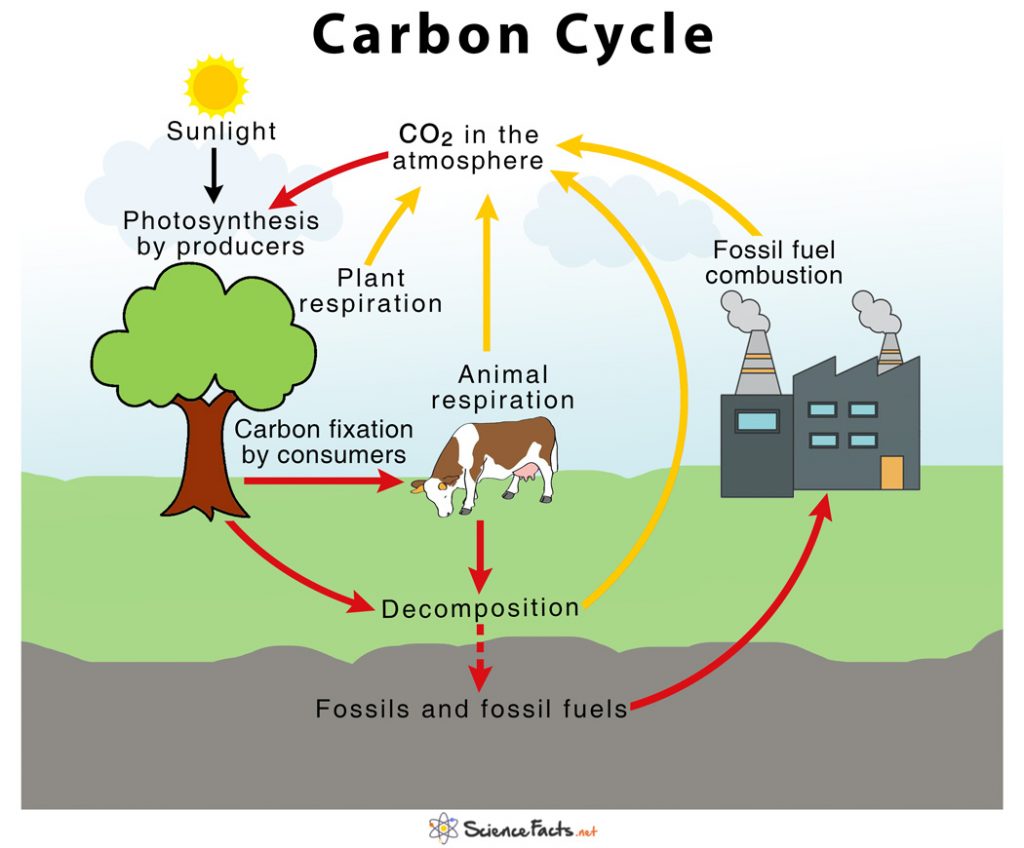Carbon Cycle
What is the Carbon Cycle?
The circulation of carbon on earth in which atmospheric carbon dioxide is converted to organic nutrients through photosynthesis and is again converted back to the inorganic state by respiration, decay, or combustion. The atmosphere, the oceans, vegetation, rocks, and soil forms the major carbon reserve of our planet.
Who discovered the Carbon Cycle?
Antoine Lavoisier and Joseph Priestley discovered the carbon cycle in the 18th century, which was later popularized by Humphry Davy.
What are the Major Steps of the Carbon Cycle?
1. Role of Primary Producers (Photosynthesis and Cellular Respiration)
Carbon present in the air as carbon dioxide is absorbed by plants, the primary producers to produce food in the form of carbohydrates by a process called photosynthesis. This forms the foundation of the carbon cycle.
Respiration by plants returns carbon dioxide to the atmosphere, thus once again contributing to the cycle in a different manner.
2. Role of Primary Consumers (Carbon Fixation and Cellular Respiration)
The primary consumers such as cows and horses use plants as their food, and carbon gets accumulated and fixed into their bodies in the form of organic carbon, a process known as carbon fixation.
Respiration by animals release carbon dioxide back to the atmosphere.
3. Role of Detritus Feeders (Decomposition)
Once plants and animals die, the fixed organic carbon is released back into the atmosphere as carbon dioxide gas through decomposition by the detritus feeders.
4. Role of Fossils and Fossil Fuels (Combustion)
The carbon that is leftover in the body of the dead organisms after decay becomes fossil fuels over many years, which on combustion releases the carbon stored in them back to the atmosphere thus completing the cycle.
Why is the Carbon Cycle Important?
Primary Function of the Carbon Cycle: To maintain the balance of carbon in nature. Since atmospheric carbon dioxide determines the rate of photosynthesis by the producers, which acts as the primary source of food production on earth, the carbon cycle helps to sustain life on earth.
Other Roles in Living Systems and the Environment:
- Carbon forms an integral component of proteins, lipids, and DNA, the building blocks of all living things
- Carbon dioxide traps the long-wavelength radiations from the sun and prevents it from escaping into space, very much like the glass walls of a greenhouse, thus acting as a blanket over the planet and controlling the temperature of the earth
How do Humans Affect the Carbon Cycle?
Human activities can interfere with the carbon cycle in two possible ways –
- Combustion of fossil fuels like coal, petroleum, and natural gases
- Indiscriminate cutting of trees or deforestation
What are the Effects of Combustion of Fossil Fuels on the Carbon Cycle?
Burning of fossil fuels releases excess carbon dioxide in the atmosphere, which is way more than the amount removed by plants during photosynthesis. This results in an increase in atmospheric carbon dioxide, thus disturbing the balance of the carbon cycle.
How Does Deforestation Affect the Carbon Cycle?
As trees and forests balance the amount of carbon in the atmosphere through photosynthesis, excessive cutting of trees increases the carbon dioxide level in the atmosphere, thus raising the temperature of the earth. This is one of the primary reasons for the negative greenhouse effects and global warming.
Article was last reviewed on Monday, November 2, 2020




